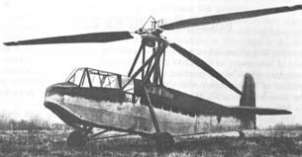
""
FOCKE-ACHGELIS
FOCKE-ACHGELIS |


|
|
|
Durante la primera mitad de la Segunda Guerra Mundial, los transportes de asalto tenían un papel preponderante en ubicar tropas detrás de las líneas enemigas, como también el aprovisionamiento de las mismas. Debido a que en algunas situaciones era imposible realizar esta tarea con los planeadores normales debido a la configuración del terreno, se comenzó el desarrollo del FA-225. Para esto se tomó el fuselaje de un planeador DFS 230 y se le aplicó el rotor tripala de un Fa 223 sobre una estructura tipo pilón. El FA-225 era arrastrado por un Junkers JU-52, pudiendo aterrizar en una distancia de 59 ft. No se llegó a utilizar en la práctica debido a que era muy lento y por lo tanto muy vulnerable al fuego enemigo. El diámetro del rotor era de 12 metros. |
|
|
|
During the first half of the second world war, the assault glide was of considerable importance in he rapid landing of troops and supplies, but its use was dependent on the availability of sufficient landing area. Where the landing area was restricted by natural or artificial obstacles, the glider's landing run could be shortened by nose braking rockets, although the landing approach remained unaltered. The idea therefore arose of exploiting the almost vertical or very steep descent to be obtained from rotory wings in autorotation, and in 1942 the fuselage of a DFS 230 glider had its fixed wings replaced by an Fa 223 three-blade rotor mounted on a structural pylon. To take the increased landing load, a braced undercarriage replaced the normal skid. This hybrid rotaglider, designated Focke Achgelis Fa 225, was towed behind a Junkers Ju-52/3m in test, during 1943, and could land within a distance of 59 ft. It was not, however, put to operational use, probably because of changing operational requirements, and possibly because its advantages were counterbalanced by the fact that the towing speed was considerably lower than that of the standard DFS 230, and it would have been more vulnerable to attack with its slower assault approach speed. Source: German Aircraft of the Second World War - JR Smith & Antony Kay - The Nautical & Aviation Publishing Company ©1972 |
|
|
|
Characteristics |
Information |
Characteristics |
Information |
| First
Flight Primer Vuelo |
1943 | Engine Motor |
No Engine |
| Seating
Capacity Plazas |
1 / |
Power Potencia |
HP |
| Empty
Weight Peso Vacío |
Lb |
Hover
Ceiling O.G.E. Estacionario O.G.E |
Ft |
| Maximum
Weight Peso Máximo |
4410 Lb |
Hover
Ceiling I.G.E. Estacionario I.G.E |
Ft |
| Vel.
Cruise Vel. crucero |
Kts |
Service
Ceiling Techo de Servicio |
Ft |
| V.N.E. V.N.E |
95 Kts |
Maximum
Range (Std) Alcance (Std) |
NM |
Copyright © 1999 / 2003